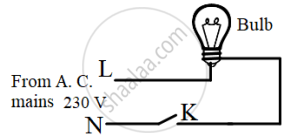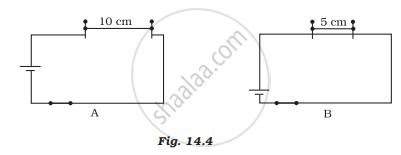Advertisements
Advertisements
प्रश्न
An electric iron of 1100 W is operated for 2 hrs daily. What will be the electrical consumption expenses for that in the month of April? (The electric company charges Rs 5 per unit of energy).
उत्तर
Electric power required for working of iron, P = 1100 W
Duration for which the iron is operated daily = 2 h = \[2 \times 60 \times 60 = 7200 s \]
Electric energy consumed by iron in 7200 s is
or, \[1 J = \frac{1}{3 . 6 \times {10}^6} \] unit
Thus,
\[237600000 J = \frac{237600000}{3 . 6 \times 1000000} = 66\] units
संबंधित प्रश्न
State four most common electrical appliances based on heating effect of electric current. Why do we use finely heated platinum wire in surgery?
An electric heater of resistance 8 Ω draws 15 A from the service mains 2 hours. Calculate the rate at which heat is developed in the heater.
Name any two effects of electric current.
An electric room heater draws a current of 2.4 A from the 120 V supply line. What current will this room heater draw when connected to 240 V supply line?
Give two reasons why nichrome alloy is used for making the heating elements of electrical appliances.
Write down the formula for the heat produced when a current I is passed through a resistor R for time t.
A heating coil has a resistance of 200 Ω. At what rate will heat be produced in it when a current of 2.5 A flows through it?
Two exactly similar heating resistances are connected (i) in series, and (ii) in parallel, in two different circuits, one by one. If the same current is passed through both the combinations, is more heat obtained per minute when they are connected in series or when they are connected in parallel? Give reason for your answer.
Give a scientific reason.
Tungsten metal is used to make a solenoid type coil in an electric bulb.
Solve the following example.
Two tungsten bulbs of wattage 100 W and 60 W power work on 220 V potential difference. If they are connected in parallel, how much current will flow in the main conductor?
Give scientific reason :
In the electric equipment producing heat e.g. iron, electric heater, boiler, toaster, etc., an alloy such as Nichrome is used, not pure metals.
Name the factors on which the heat produced in a wire depends when current is passed in it, and state how does it depend on the factors stated by you.
Rewrite the following statement by selecting the correct option:
1 A = ____________ mA.
The ‘live’ and the ‘neutral’ wires have potential difference of _______.
What is overloading?
When does overloading occur?
Name some devices that run using heat effect of electric current
Explain the heating effect of electric current.
The heating element of an electric iron is made up of:
An electric kettle consumes 1 kW of electric power when operated at 220 V. A fuse wire of what rating must be used for it?
Three incandescent bulbs of 100 W each are connected in series in an electric circuit. In another circuit another set of three bulbs of the same wattage are connected in parallel to the same source.
- Will the bulb in the two circuits glow with the same brightness? Justify your answer.
- Now let one bulb in both the circuits get fused. Will the rest of the bulbs continue to glow in each circuit? Give reason.
(a) Observe the diagram given below and state whether the bulb will glow or not when we switch on K.

(b) Is it safe to handle the bulb when the switch is OFF?
(c) Give a reason for your answer in (b).
An electric cell produces electricity from the __________ ___________ in it.
Name two electric devices for each where
(i) the heating effect of current is used and
(ii) the magnetic effect of current is used.
Paheli took a wire of length of 10 cm. Boojho took a wire of 5 cm of the same material and thickness. Both of them connected the wires as shown in the circuit given in Figure 14.4. The current flowing in both circuits is the same.
(i) Will the heat produced in both cases be equal? Explain
(ii) Will the heat produced be the same if the wires taken by them are of equal lengths but of different thicknesses? Explain.

What are the uses of electromagnets?
What is an electric fuse made up of?
What are the factors affecting heating effect of electric current?
Copper wire offers very little ______ and does not get heated up quickly.
Fuse is a strip of alloy wire which is made up of lead and tin with a very low ______.
Name the effect of the current responsible for the glow of the bulb in an electrical circuit.
Explain why fuse wire is always connected in a series arrangement.
What is the heating effect of electric current?
Anannya responded to the question: Why do electrical appliances with metallic bodies are connected to the mains through a three-pin plug, whereas an electric bulb can be connected with a two-pin plug?
She wrote: Three-pin connections reduce heating of connecting wires.
- Is her answer correct or incorrect? Justify.
- What is the function of a fuse in a domestic circuit?
When a current I flows through a wire of resistance R for time t then the electrical energy produced is given by ______.
An electric iron is rated 220 V, 2 kW. If the iron is used for 3h daily find the cost of running it for one week if it costs ₹ 4.25 per kWh.
